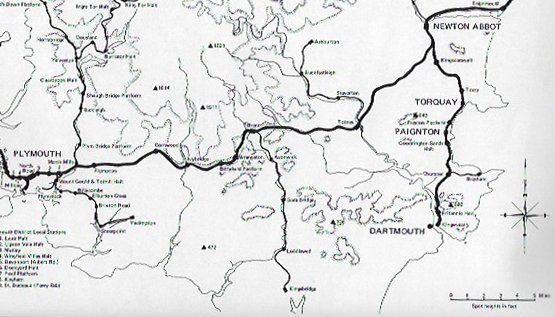Bigbury-on-Sea
Bigbury-on-Sea
A new 4mm layout by John Shaw.
The History (The prototype history is well defined in Great Western Journal Issue 9 1994)
In the 1860s demands for better transport facilities in the South Hams area of Devon led to proposals for the “South Hams Railway”, a scheme, under which a line would be constructed from Plympton to Yealmpton, Modbury, Kingsbridge and Dartmouth, there to connect with the Dartmouth and Torbay Railway. This plan envisaged a 52 mile railway through the whole of the fertile and picturesque and now almost inaccessible country between Torquay and Plymouth. The line would have required some heavy earthworks with a major viaduct across the river Dart at Dartmouth.
The scheme was supported by the L & SWR and represented a considerable threat to Great Western interests in the South Hams area. Capital could not be raised, and the scheme did not go ahead. Meanwhile, there were proposals for a line from South Brent to the town of Kingsbridge which, if successfully implemented, would have provided a rail link for the central district of the South Hams.
Because of the proposals the Plymouth and Dartmoor Railway was persuaded to sponsor a branch line from Plymstock to Yealmpton and Modbury, a distance of 12 miles through relatively easy terrain. In reality the Plymouth and Dartmoor Railway was acting in close liaison with the L & SWR and although the Modbury scheme was a separate promotion, the Great Western feared that the rival company was seeking to extend its influence towards Torbay.
The Great Western board were concerned by this threat of the South Western’s expansion in the South Hams, and there were thoughts of a rival GW branch to Modbury. In the event, common sense prevailed and the GWR built the line from Plymstock to Yealmpton even though the line was of doubtful value.
So now history is changed by me as follows:
The Plymouth to Yealmpton branch was a Great Western Railway single track branch railway line in Devon, England that ran from Plymstock to Yealmpton, Modbury and extended to pass through Aveton Gifford and then drop South to Bigbury-on-Sea. It opened in 1898 and the passenger train service ran from Plymouth Millbay, and with the route now to the seaside resort of Bigbury-on-Sea, the line took on more traffic, and continued in service long after the original closure in the 1930’s.
The model.
Following the success of the water feature on the club’s “Redbridge Wharf” layout I wanted to build a branch line terminus at a seaside resort. I had previously built a 7mm model of my imaginary station at Aveton Gifford and this was further extended to a fiddle yard known as Bigbury-on-Sea. It seemed an obvious conclusion that this town should be my chosen destination of the new 4mm layout.
Baseboards were commercially built by Model Railway Solutions of Poole and have proved flat and reliable. Track is the code 75 bullhead track by PECO. Sleeper spacings amended to give more prototypical rail lengths. I wanted to have a gentle curve throughout the station and found that the PECO points can be carefully curved to match the continuous curve. My layouts normally feature a level crossing or a canal, Bigbury has a working single gated level crossing. For exhibitions, an extra scenic board is added to give a short run before entering a tunnel to the fiddle yard. At home I only have room for the 3 boards. Track alignment between baseboards 2 and 4 is similar to the alignment between baseboards 2 & 3 and 3 & 4.
The stock is controlled by DCC, but the signals and points are controlled through an interlocked lever frame. Attached to the frame and interlocked with the lever frame is a level crossing wheel, complete with rack and pinion drive, the connection to the gates being made electrically via a micro-switch activated by the rack.
The line enters the Bigbury area having tunnelled through a nearby hill and follows the river course until reaching the station which was constructed near to the beach area.
The fiddle yard is a sector plate and has 7 tracks. Eight trains can be stored as one track houses the railcar and auto-train. Two hidden storage roads are available on baseboard 3 for shunting the arrived trains, so stock handling is minimal.
The station has a main platform, a bay platform which has a carriage siding leading from it together with a loco shed. The auto train can be housed overnight to allow an early ‘up’ train for workers travelling to Plymouth. The yard, (based loosely on Minehead), has a goods shed, cattle dock and loading bank for general merchandise. Coal is stored in the staithes and the yard has stabling for two horses that were sometimes used to move wagons around when no shunting loco was available. These days a station pilot is left at Bigbury as the shed allows for overnight storage and minor maintenance.
Track was laid on 2mm foam rubber base. My mistake in an attempt to reduce noise was to use “Copydex” to glue the track down. All went well until holes were drilled for wiring. The drill bit snags on the glue and pulls the glue from around the hols removing it and generally causing a mess. The answer is to cut around the intended hole first.
I tried some scale fishplates which had been 3D printed but found them too fiddly and not strong enough. The PECO fishplates look good and have the 4 bolts represented. When painted I believe they look convincing. All track sections are wired back to the BUS under the boards (two lengths of tinned wires held in place at each end of the board). All track was given a coat of thinned grey emulsion bought as tester pots from the local DIY store. Ballasting was by using Woodland Scenics fine light grey ballast and stuck with Ballast Bond.



